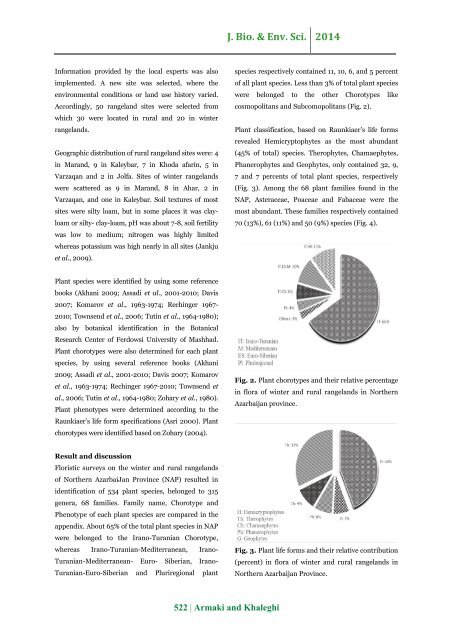Presentation of flora, life forms and chorology of rural range plants in the North East Azarbaijan province, Iran
Abstract Floristic studies are fundamental for the applied sciences such as rangeland management and conservation. Unique ecological and climatic conditions in the North East Azarbaijan Province (NAP) make it a remarkable habitat for the floristic studies. Plant species were collected from 50 field sites, representing major habitats of winter and rural rangelands. Surveys were conducted during active growth periods in 2012 and 2013. Plant species were identified and their chorology and life form determined through laboratory examinations and by using reference books. Floristic surveys resulted in identification of 534 plant species, belonged to 315 genus and 68 families. Asteraceae, Poaceae and Fabaceae were respectively the most abundant plant families. Among the life forms, Hemicryptophytes, Therophytes, Chamaephytes, Phanerophytes and Geophytes included 45, 32, 9, 7 and 7% of the total species, respectively. Irano-Turanian was the most dominant (65%) Chorotypes. The dominance of Hemicryptophytes and Therophytes, as well as vast distribution of Chamaephytes, can be referred to the simultaneous effects of climate fluctuations and livestock grazing on the flora of winter and rural rangelands in NAP.
Abstract
Floristic studies are fundamental for the applied sciences such as rangeland management and conservation. Unique ecological and climatic conditions in the North East Azarbaijan Province (NAP) make it a remarkable habitat for the floristic studies. Plant species were collected from 50 field sites, representing major habitats of winter and rural rangelands. Surveys were conducted during active growth periods in 2012 and 2013. Plant species were identified and their chorology and life form determined through laboratory examinations and by using reference books. Floristic surveys resulted in identification of 534 plant species, belonged to 315 genus and 68 families. Asteraceae, Poaceae and Fabaceae were respectively the most abundant plant families. Among the life forms, Hemicryptophytes, Therophytes, Chamaephytes, Phanerophytes and Geophytes included 45, 32, 9, 7 and 7% of the total species, respectively. Irano-Turanian was the most dominant (65%) Chorotypes. The dominance of Hemicryptophytes and Therophytes, as well as vast distribution of Chamaephytes, can be referred to the simultaneous effects of climate fluctuations and livestock grazing on the flora of winter and rural rangelands in NAP.
Create successful ePaper yourself
Turn your PDF publications into a flip-book with our unique Google optimized e-Paper software.
J. Bio. & Env. Sci. 2014<br />
Information provided by <strong>the</strong> local experts was also<br />
implemented. A new site was selected, where <strong>the</strong><br />
environmental conditions or l<strong>and</strong> use history varied.<br />
Accord<strong>in</strong>gly, 50 <strong>range</strong>l<strong>and</strong> sites were selected from<br />
which 30 were located <strong>in</strong> <strong>rural</strong> <strong>and</strong> 20 <strong>in</strong> w<strong>in</strong>ter<br />
<strong>range</strong>l<strong>and</strong>s.<br />
Geographic distribution <strong>of</strong> <strong>rural</strong> <strong>range</strong>l<strong>and</strong> sites were: 4<br />
<strong>in</strong> Mar<strong>and</strong>, 9 <strong>in</strong> Kaleybar, 7 <strong>in</strong> Khoda afar<strong>in</strong>, 5 <strong>in</strong><br />
Varzaqan <strong>and</strong> 2 <strong>in</strong> Jolfa. Sites <strong>of</strong> w<strong>in</strong>ter <strong>range</strong>l<strong>and</strong>s<br />
were scattered as 9 <strong>in</strong> Mar<strong>and</strong>, 8 <strong>in</strong> Ahar, 2 <strong>in</strong><br />
Varzaqan, <strong>and</strong> one <strong>in</strong> Kaleybar. Soil textures <strong>of</strong> most<br />
sites were silty loam, but <strong>in</strong> some places it was clayloam<br />
or silty- clay-loam, pH was about 7-8, soil fertility<br />
was low to medium; nitrogen was highly limited<br />
whereas potassium was high nearly <strong>in</strong> all sites (Jankju<br />
et al., 2009).<br />
species respectively conta<strong>in</strong>ed 11, 10, 6, <strong>and</strong> 5 percent<br />
<strong>of</strong> all plant species. Less than 3% <strong>of</strong> total plant species<br />
were belonged to <strong>the</strong> o<strong>the</strong>r Chorotypes like<br />
cosmopolitans <strong>and</strong> Subcomopolitans (Fig. 2).<br />
Plant classification, based on Raunkiaer’s <strong>life</strong> <strong>forms</strong><br />
revealed Hemicryptophytes as <strong>the</strong> most abundant<br />
(45% <strong>of</strong> total) species. Therophytes, Chamaephytes,<br />
Phanerophytes <strong>and</strong> Geophytes, only conta<strong>in</strong>ed 32, 9,<br />
7 <strong>and</strong> 7 percents <strong>of</strong> total plant species, respectively<br />
(Fig. 3). Among <strong>the</strong> 68 plant families found <strong>in</strong> <strong>the</strong><br />
NAP, Asteraceae, Poaceae <strong>and</strong> Fabaceae were <strong>the</strong><br />
most abundant. These families respectively conta<strong>in</strong>ed<br />
70 (13%), 61 (11%) <strong>and</strong> 50 (9%) species (Fig. 4).<br />
Plant species were identified by us<strong>in</strong>g some reference<br />
books (Akhani 2009; Assadi et al., 2001-2010; Davis<br />
2007; Komarov et al., 1963-1974; Rech<strong>in</strong>ger 1967-<br />
2010; Townsend et al., 2006; Tut<strong>in</strong> et al., 1964-1980);<br />
also by botanical identification <strong>in</strong> <strong>the</strong> Botanical<br />
Research Center <strong>of</strong> Ferdowsi University <strong>of</strong> Mashhad.<br />
Plant chorotypes were also determ<strong>in</strong>ed for each plant<br />
species, by us<strong>in</strong>g several reference books (Akhani<br />
2009; Assadi et al., 2001-2010; Davis 2007; Komarov<br />
et al., 1963-1974; Rech<strong>in</strong>ger 1967-2010; Townsend et<br />
al., 2006; Tut<strong>in</strong> et al., 1964-1980; Zohary et al., 1980).<br />
Plant phenotypes were determ<strong>in</strong>ed accord<strong>in</strong>g to <strong>the</strong><br />
Raunkiaer’s <strong>life</strong> form specifications (Asri 2000). Plant<br />
chorotypes were identified based on Zohary (2004).<br />
Fig. 2. Plant chorotypes <strong>and</strong> <strong>the</strong>ir relative percentage<br />
<strong>in</strong> <strong>flora</strong> <strong>of</strong> w<strong>in</strong>ter <strong>and</strong> <strong>rural</strong> <strong>range</strong>l<strong>and</strong>s <strong>in</strong> Nor<strong>the</strong>rn<br />
<strong>Azarbaijan</strong> prov<strong>in</strong>ce.<br />
Result <strong>and</strong> discussion<br />
Floristic surveys on <strong>the</strong> w<strong>in</strong>ter <strong>and</strong> <strong>rural</strong> <strong>range</strong>l<strong>and</strong>s<br />
<strong>of</strong> Nor<strong>the</strong>rn AzarbaiJan Prov<strong>in</strong>ce (NAP) resulted <strong>in</strong><br />
identification <strong>of</strong> 534 plant species, belonged to 315<br />
genera, 68 families. Family name, Chorotype <strong>and</strong><br />
Phenotype <strong>of</strong> each plant species are compared <strong>in</strong> <strong>the</strong><br />
appendix. About 65% <strong>of</strong> <strong>the</strong> total plant species <strong>in</strong> NAP<br />
were belonged to <strong>the</strong> <strong>Iran</strong>o-Turanian Chorotype,<br />
whereas <strong>Iran</strong>o-Turanian-Mediterranean, <strong>Iran</strong>o-<br />
Turanian-Mediterranean- Euro- Siberian, <strong>Iran</strong>o-<br />
Turanian-Euro-Siberian <strong>and</strong> Pluriregional plant<br />
Fig. 3. Plant <strong>life</strong> <strong>forms</strong> <strong>and</strong> <strong>the</strong>ir relative contribution<br />
(percent) <strong>in</strong> <strong>flora</strong> <strong>of</strong> w<strong>in</strong>ter <strong>and</strong> <strong>rural</strong> <strong>range</strong>l<strong>and</strong>s <strong>in</strong><br />
Nor<strong>the</strong>rn <strong>Azarbaijan</strong> Prov<strong>in</strong>ce.<br />
522 | Armaki <strong>and</strong> Khaleghi





![Review on: impact of seed rates and method of sowing on yield and yield related traits of Teff [Eragrostis teff (Zucc.) Trotter] | IJAAR @yumpu](https://documents.yumpu.com/000/066/025/853/c0a2f1eefa2ed71422e741fbc2b37a5fd6200cb1/6b7767675149533469736965546e4c6a4e57325054773d3d/4f6e6531383245617a537a49397878747846574858513d3d.jpg?AWSAccessKeyId=AKIAICNEWSPSEKTJ5M3Q&Expires=1718665200&Signature=%2BX7h9AR8a2okmFguHDw37MQ9d7s%3D)












